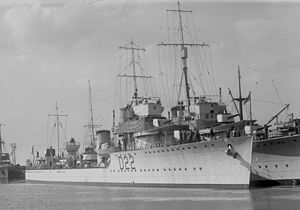 HMAS Waterhen, with HMAS Stuart in background
| |
| History | |
|---|---|
| Name | Waterhen |
| Namesake | Waterhen |
| Builder | Palmers Shipbuilding and Iron Company |
| Laid down | 3 July 1917 |
| Launched | 26 March 1918 |
| Completed | 17 July 1918 |
| Commissioned | July 1918 |
| Decommissioned | October 1933 |
| Fate | Transferred to Royal Australian Navy |
| Name | Waterhen |
| Commissioned | 11 October 1933 |
| Decommissioned | 9 October 1934 |
| Recommissioned | 14 April 1936 |
| Decommissioned | 1 June 1938 |
| Recommissioned | 1 September 1939 |
| Nickname(s) | The Chook[1] |
| Honours and awards | |
| Fate | Sunk by dive bombers, 30 June 1941 |
| General characteristics | |
| Class and type | W-class destroyer |
| Displacement | 1,100 tons standard |
| Length |
|
| Beam | 29 ft 6 in (9.0 m) |
| Draught | 13 ft 11 in (4.2 m) |
| Propulsion | 3 × White=Forster boilers, 2 × Brown-Curtis turbines, 27,000 shp (20,000 kW), two shafts |
| Speed | 34 knots (63 km/h; 39 mph) |
| Range | 3,560 nautical miles (6,590 km; 4,100 mi) at 12 knots (22 km/h; 14 mph) |
| Complement | 6 officers, 113 sailors |
| Armament |
|
HMAS Waterhen (D22/I22) was a W-class destroyer that served in the Royal Navy (as HMS Waterhen (G28/D22)) and the Royal Australian Navy (RAN). Built during World War I, the destroyer was completed in mid-1918, and commissioned into the Royal Navy. In 1933, Waterhen and four other British ships were transferred to the RAN. The ship's early RAN career was uneventful, with periods spent decommissioned in reserve, but she was reactivated in September 1939, and deployed to the Mediterranean as part of the Australian destroyer force: the Scrap Iron Flotilla. During her time in the Mediterranean, Waterhen was involved in escort and patrol duties, performed shore bombardments, and participated in Allied evacuations from Greece and Crete. On 29 June 1941, while operating with the Tobruk Ferry Service, Waterhen was heavily damaged by two Italian Regia Aeronautica's aircraft, dive bombers Ju 87 Stuka (renamed Picchiatello) of 239 squadriglia, flown by pilots Serg.mag. Ennio Tarantola e Serg. Lastrucci.[2] Attempts to tow the ship to port were unsuccessful, and she sank on 30 June 1941, the first RAN ship lost to combat in World War II.